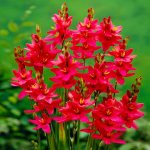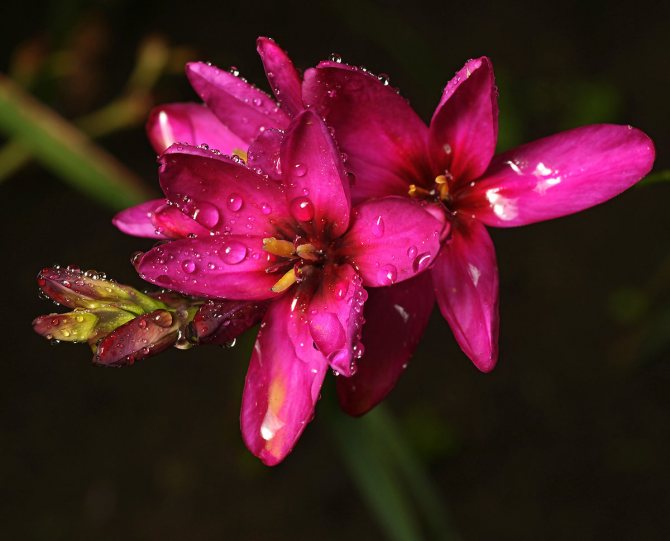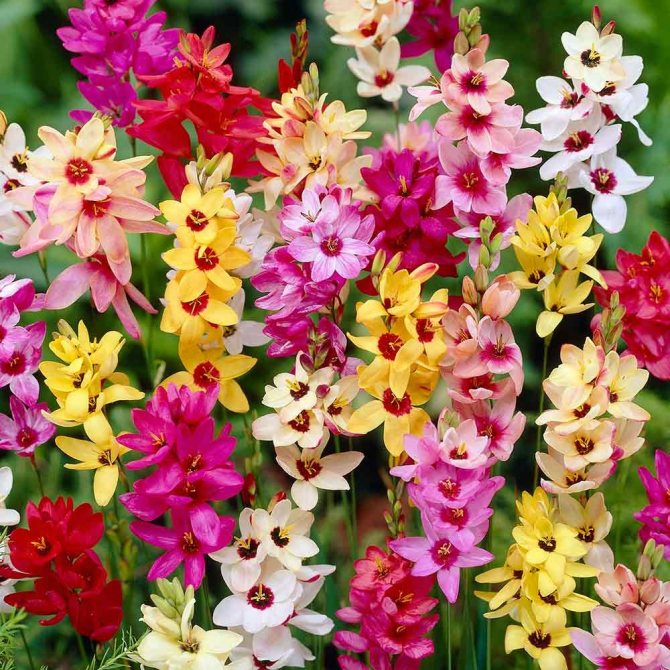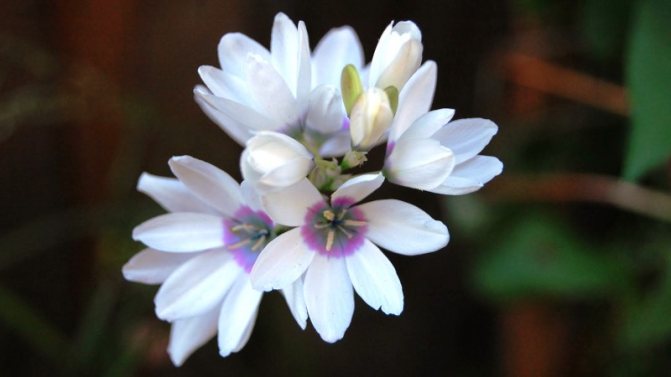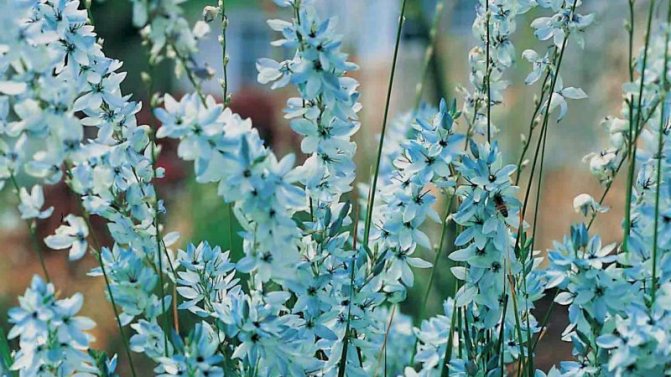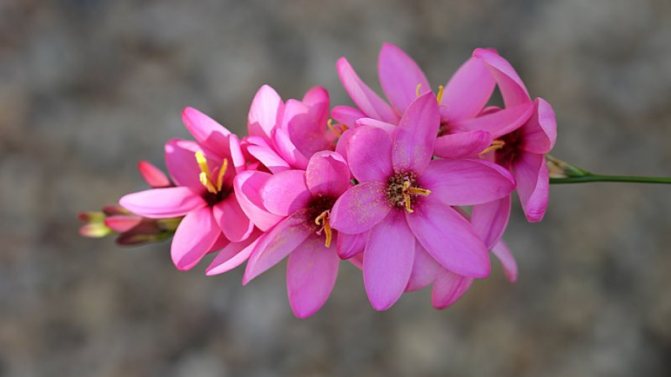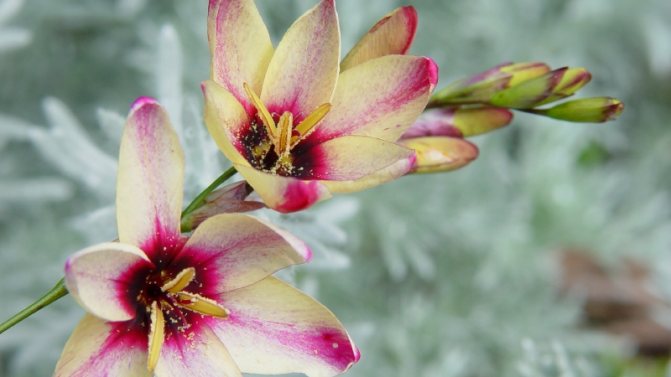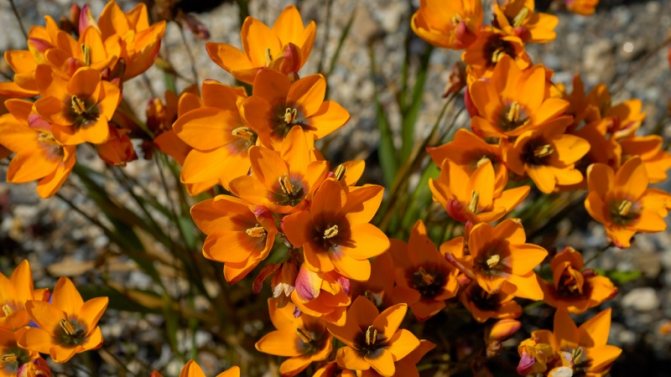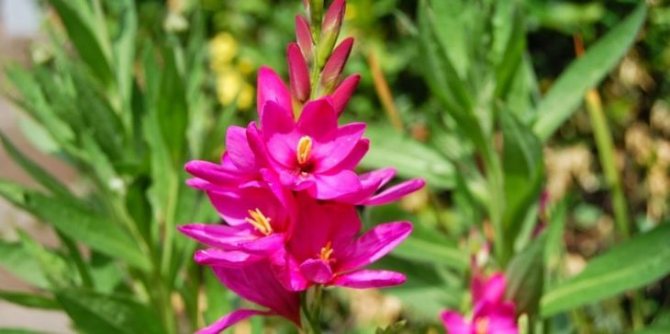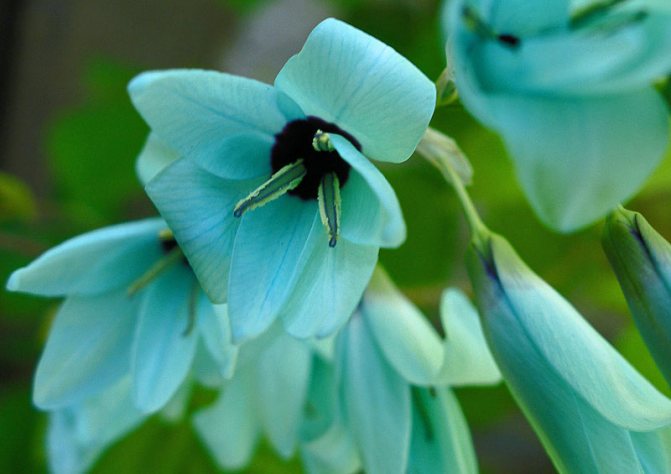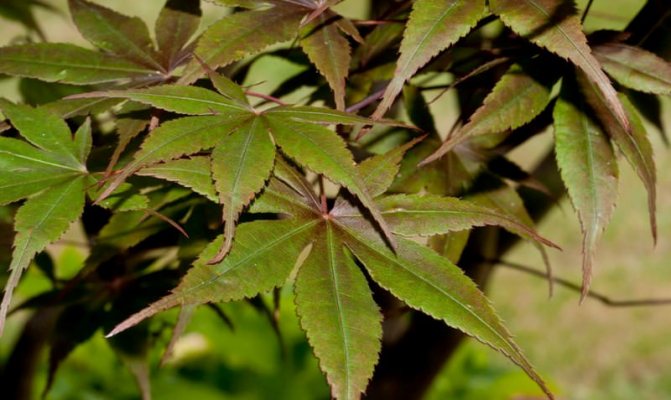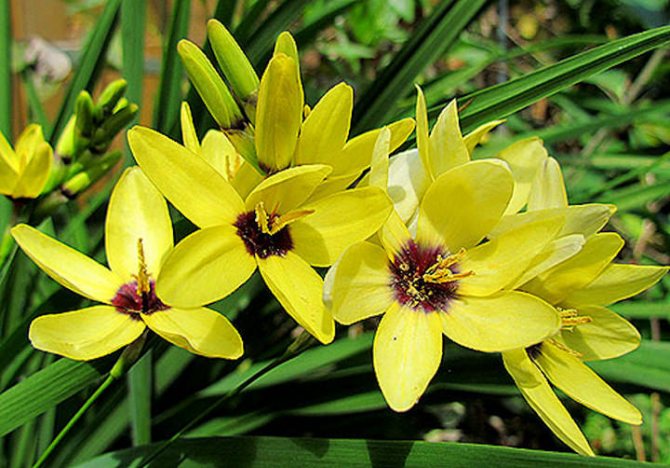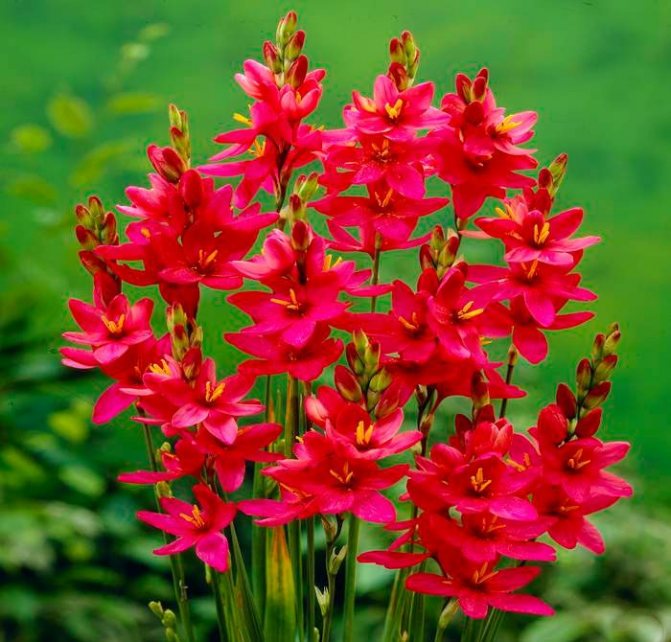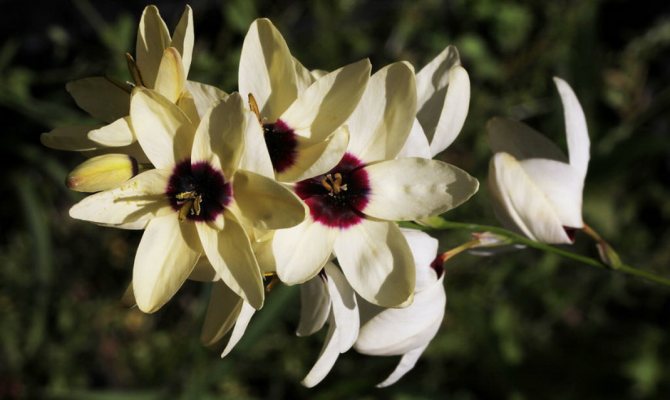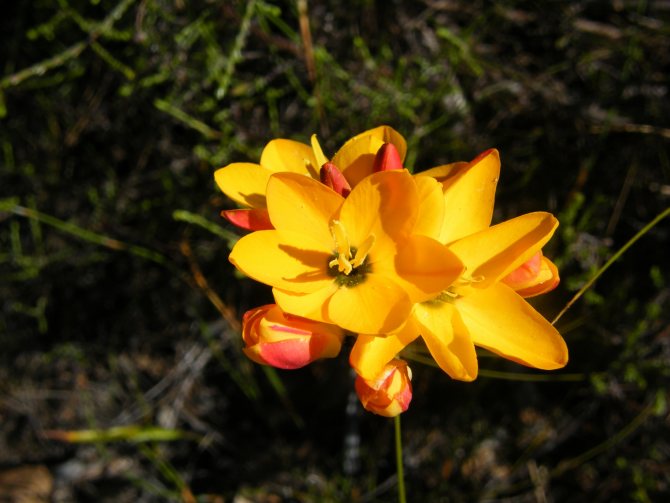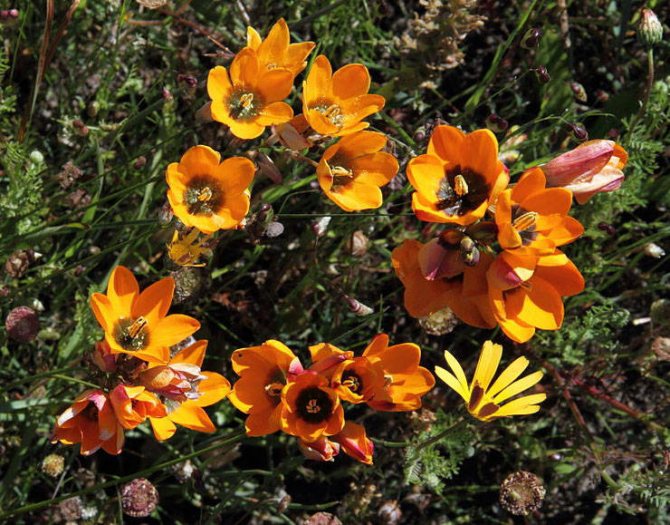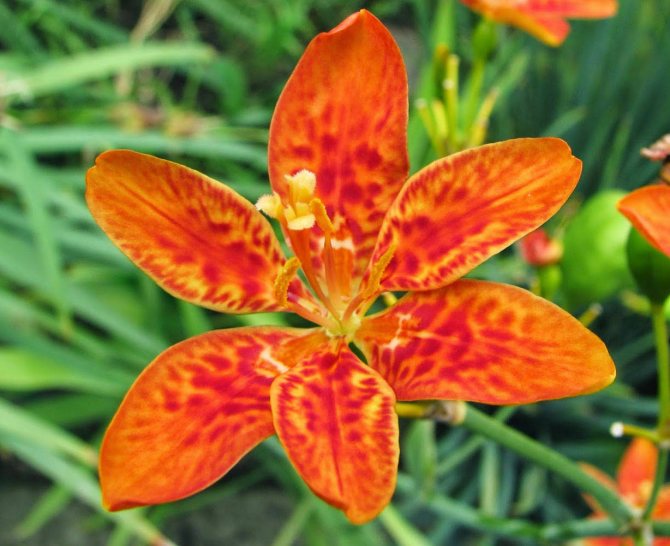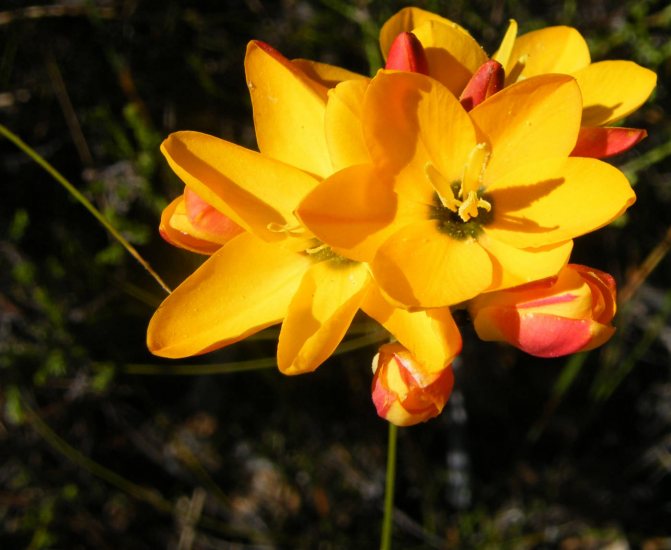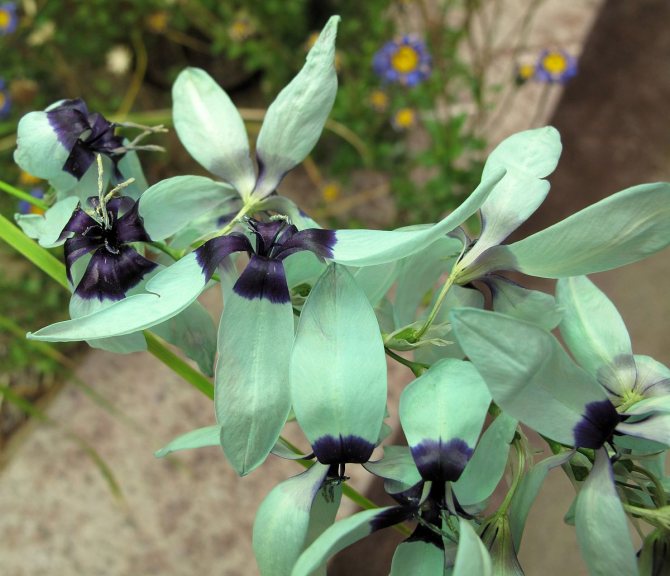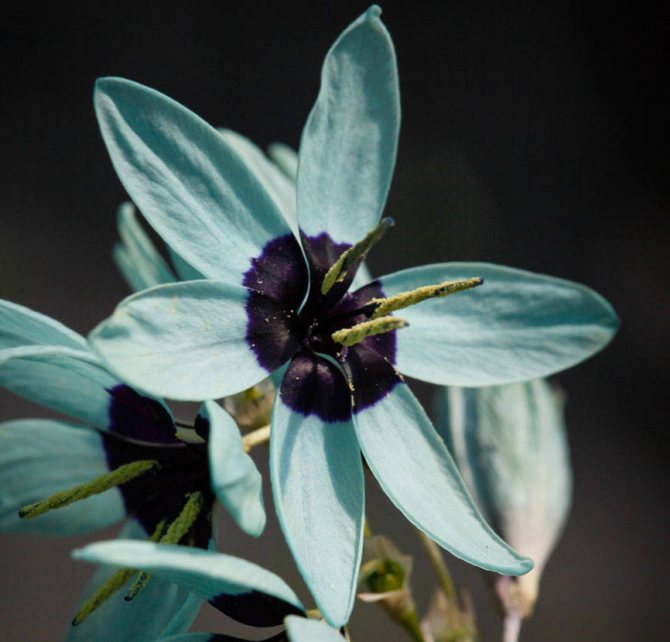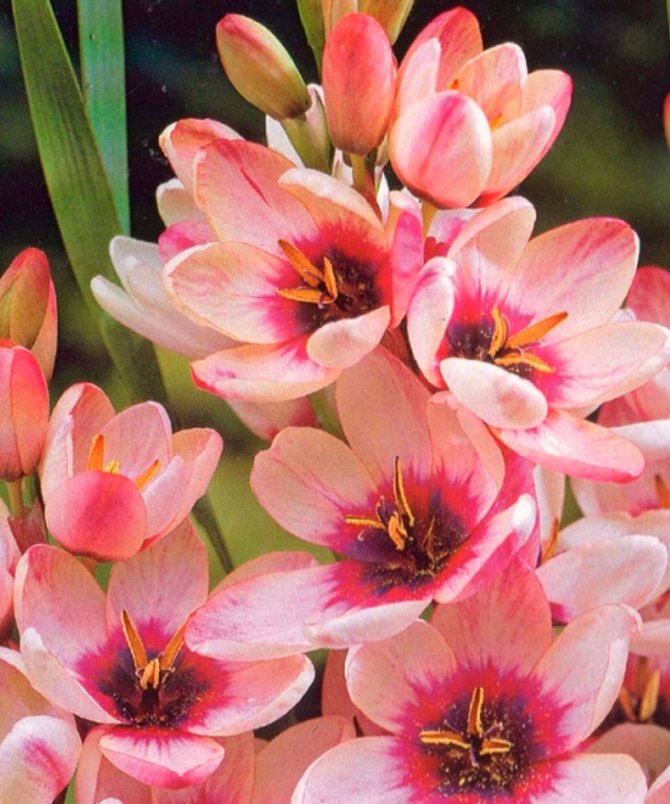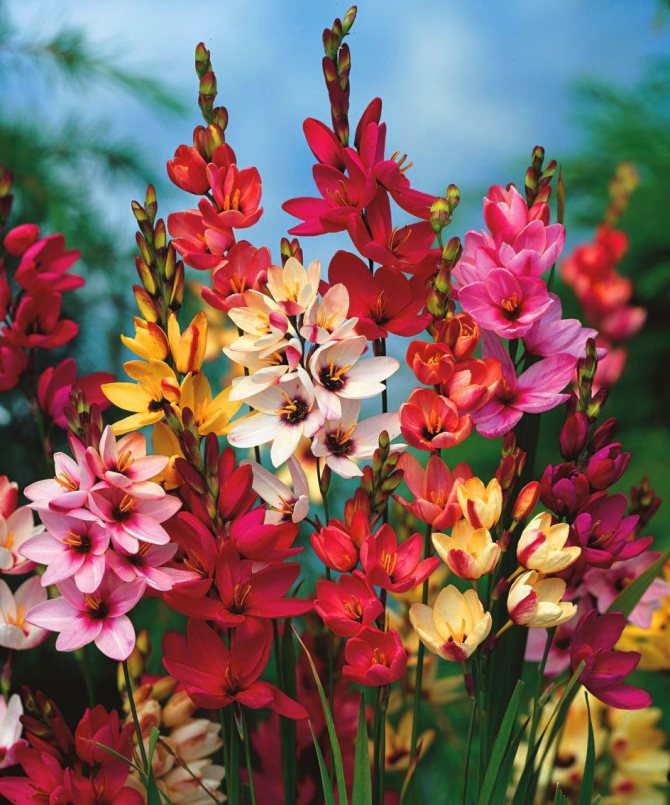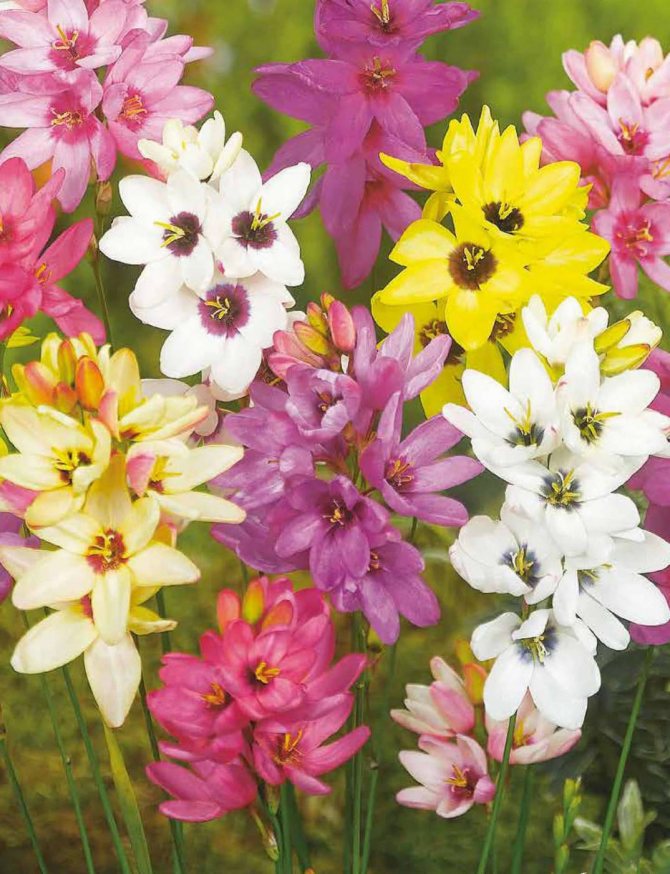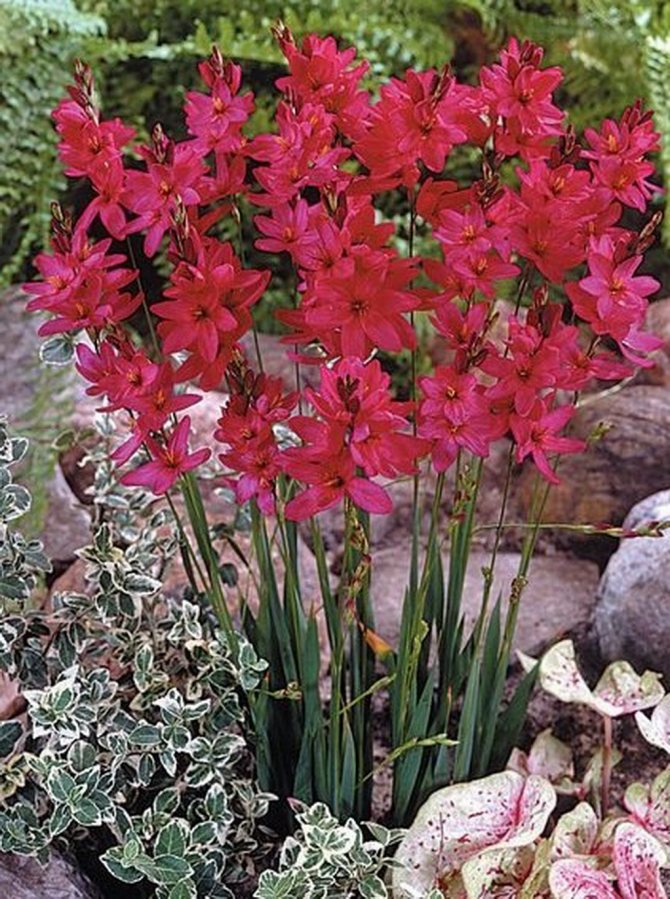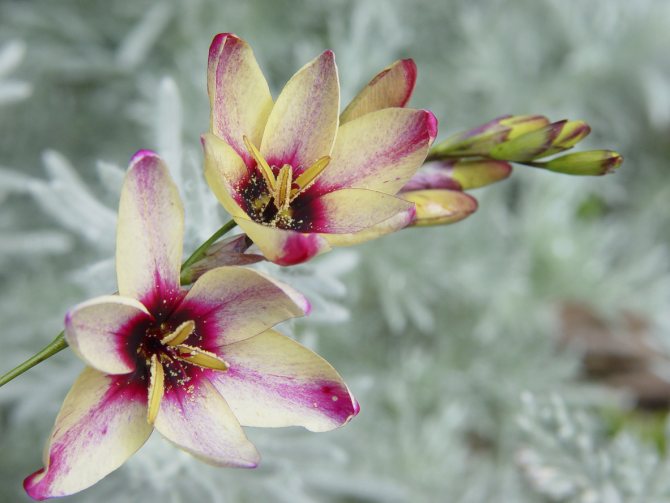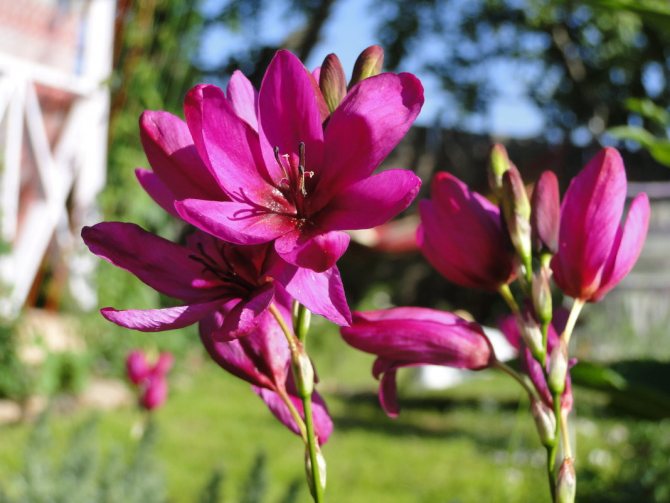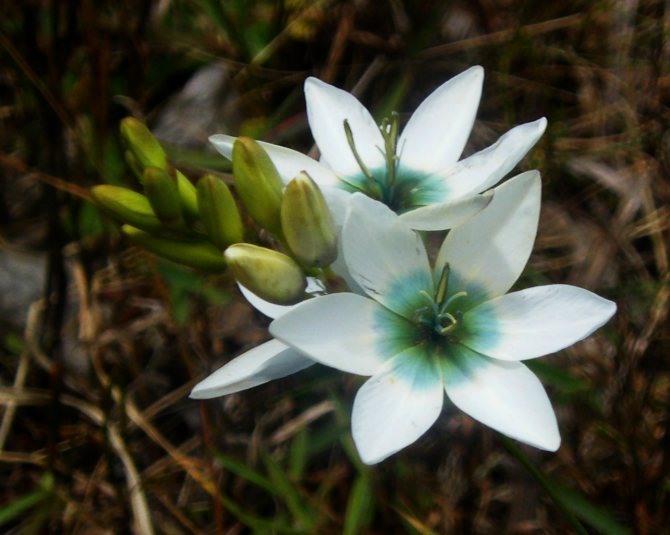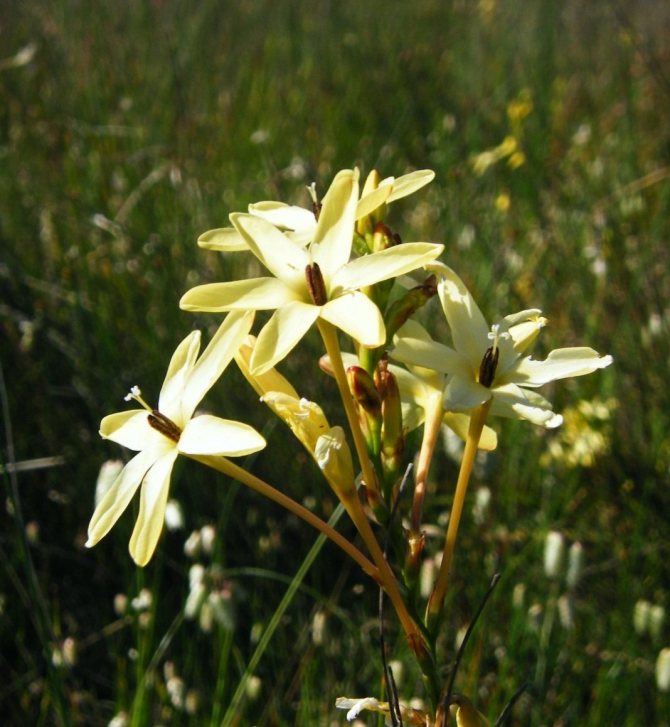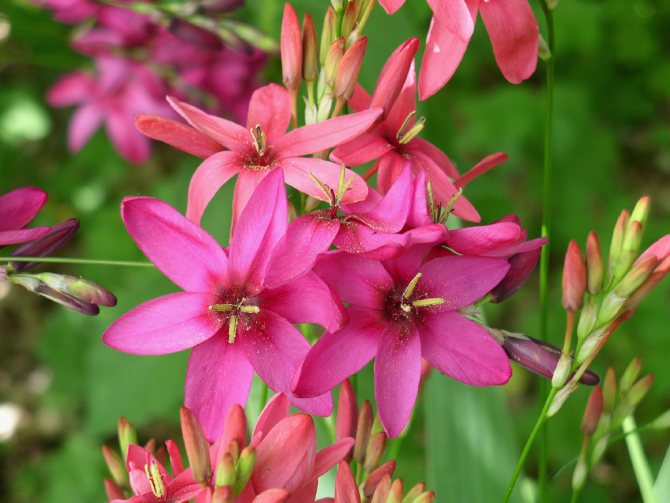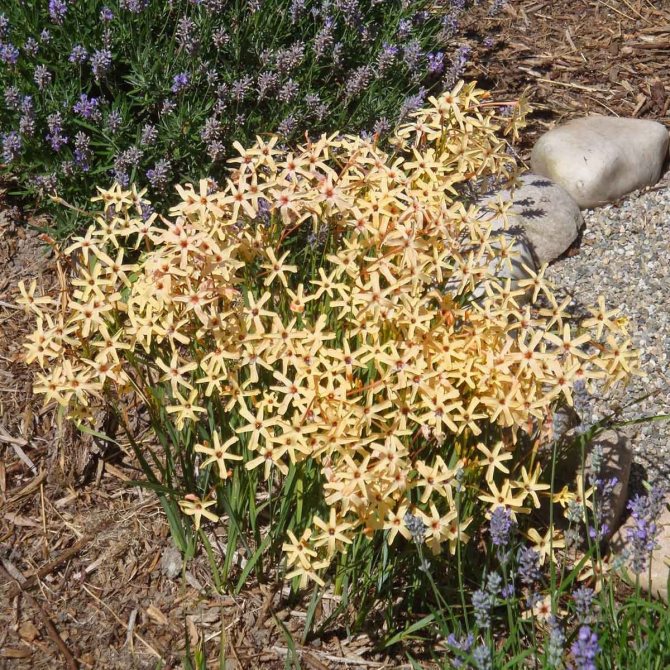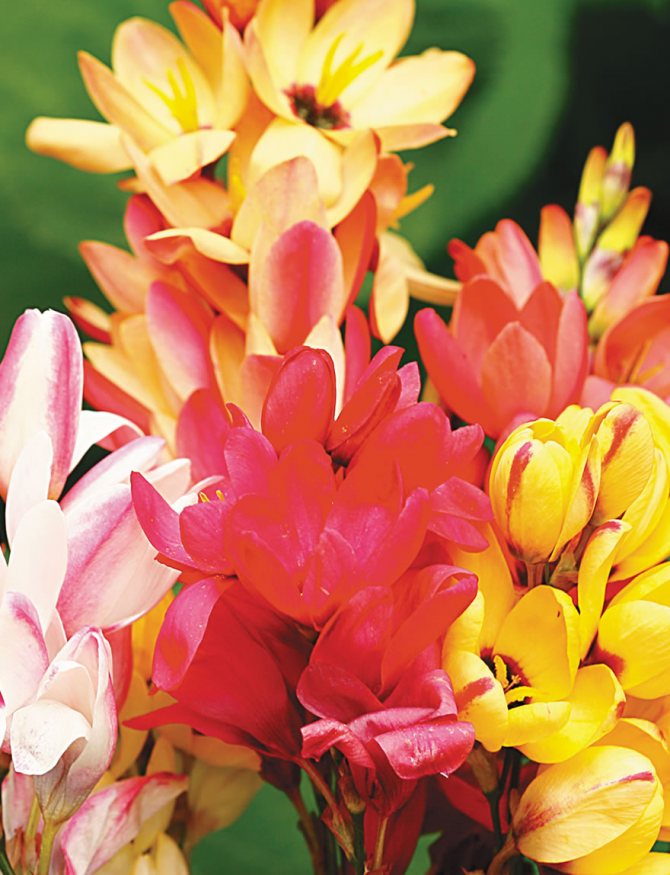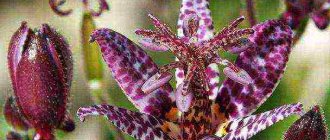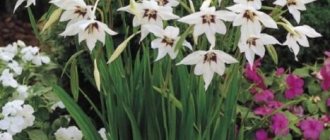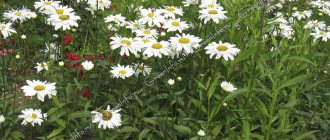The herbaceous perennial plant Ixia is a member of the Iris family. According to information taken from various sources, there are from 40 to more than 60 different species in this genus. This plant comes from South Africa, namely, from the Cape region. The scientific name of this genus comes from the Greek word, which means "bird glue", meaning the sticky sap of a plant. Cultivation of this flower began in the 18th century. To date, the most widespread varieties are Ixia, which are hybrids, they have a common name - Ixia hybrid. At the same time, species ixia are becoming less popular every year.
Ixia. Description of the plant
- Ixia is a perennial plant with a bulbous root system.
- Ixia belongs to the Iris family.
- Ixia is native to the countries of South Africa.
- Ixia has been actively cultivated for decorative purposes since 1770.
- The reason for this name of the plant is believed to be the attitude to the word "ixios", which means "bird glue". Bird glue is a sticky compound for catching birds or insects. Ixia, on the other hand, has a rather sticky nectar that attracts insects.
- Ixia is capable of reaching 50-70 cm in height. Of course, this depends on the variety and conditions for growth and development.
- Ixia has a very thin and graceful stem, on which spike-shaped inflorescences are located.
- Ixia flowers can be of a variety of colors and shades. This feature in many ways attracts gardeners who want to add color to their site.
- Ixia flowers exude a delicate and delicate aroma that attracts not only people, but also bees.
- The thin stem of Ixia is "decorated" with a small number of xiphoid leaves that grow directly from the bulb.
- Ixia is a summer flower. The active flowering phase begins in late spring or early summer. It will not take long to rejoice in the colorful colors - about 1 month. Flowers immediately attract attention with a riot of juicy flowers.
- In the dark, delicate ixia flowers "hide". As the sun rises, they open their petals again.
- About 25 species of ixia are known, each of which is represented by a large number of varieties. The most cultivated are hybrid varieties of Ixia.
- Ixia is a southern plant from the tropics. She loves sun and water. For novice gardeners, growing this plant can seem daunting due to its capriciousness to growing conditions.
- Bright ixia flowers in the form of small stars look spectacular both in independent plantings and in combination with other ornamental plants. Gardeners plant Ixia in rock gardens, group beds, near paths, etc.

Ixia features
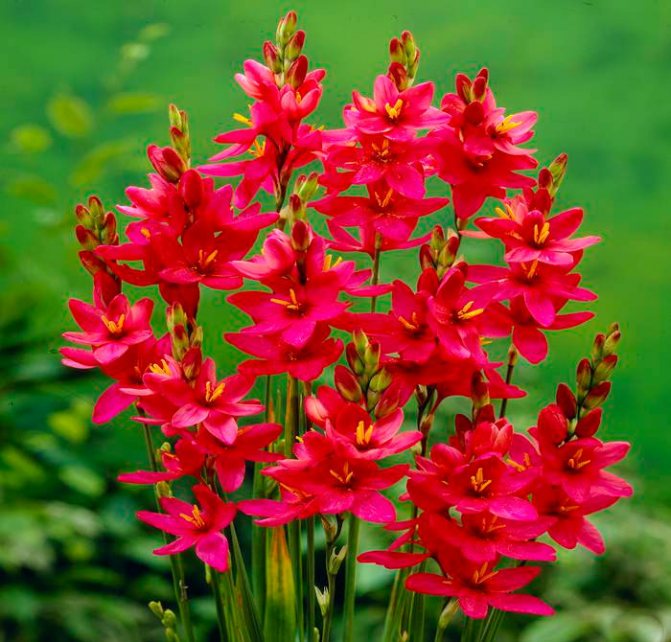

Ixia is a bulbous plant, the height of which can vary from 0.15 to 0.7 m. The shoots are thin. Narrow linear long leaf plates are xiphoid and two-row. On the peduncle there are about 10 wide open flowers, reaching from 25 to 50 mm in diameter. The flowers include 6 petals of red, yellow, white or pink color, while closer to the middle, the color becomes more saturated and dark, for example: black, dark red or brown. Flowering is observed in the last spring weeks or the first - in the summer. At night, as well as in cloudy weather, the flowers of this plant do not open.The flowers have a not very strong, but rather pleasant smell, which is attractive to various insects, for example, to bees.
Ixia. Varieties
Experienced gardeners know that it is best to grow several varieties of Ixia at the same time to create the most effective flower arrangements. Decide which color you are missing and choose the appropriate variety. At the moment, about 20 species and a large number of varieties are known. The most popular are hybrid varieties.
Ixia Hymenokallis
Ixia Hymenokallis immediately attracts with its unique flower shape. They differ from the usual shape of Ixia flowers, which resemble small stars. This species of Ixia has long, arcuate petals that make the flower look like the sun. Very often Ixia Hymenokallis is compared with daffodils. The flower blooms in late spring or early summer. Peduncles reach a height of 70 cm. Ixia can have flowers of snow-white or light purple hue. The delicate scent attracts a large number of butterflies and bees. This type of ixia will be a great exotic decoration for your garden.
Ixia green-flowered
Green-flowered Ixia is a rather rare plant. But, if you manage to find seeds of a similar variety, then be sure to try to grow this beautiful plant. Gardeners are attracted by an interesting and unusual color combination. The absolutely black center of the flower is surrounded by delicate emerald-colored petals. Inflorescences, like most Ixia varieties, are spike-shaped. The flowering period begins in early summer. Such a plant will certainly become the "highlight" of the flower bed on the site.
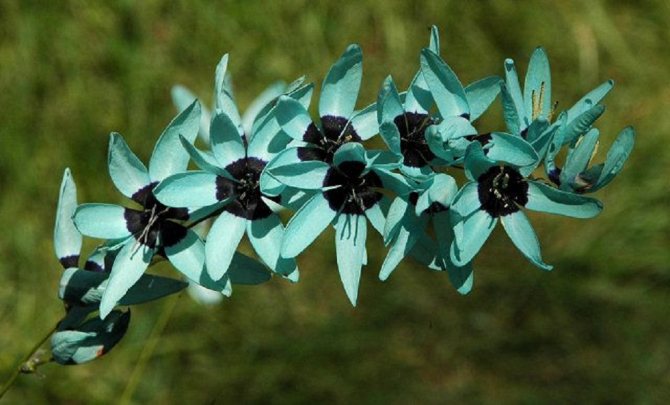

Ixia spotted
Ixia spotted is also not inferior in exotic appearance to its "brothers". The dark middle of the flower is surrounded by spotted petals. The petals are simple, smooth, rounded. Also, the stem of Ixia spotted is framed with green narrow leaves. The plant grows up to 45-50 cm. Ixia spotted always attracts the eye and conquers with its delicate aroma.
Ixia hybrid
Ixia hybrid is a species that combines many hybrid varieties. Most of these varieties are incredibly popular with gardeners. You will be surprised at the variety of colors and shades that hybrid ixia can give you. The cultivation of several varieties of Ixia hybrid will be especially effective. The undoubted advantage of hybrid varieties of Ixia is less "capriciousness", greater plant resistance to adverse environmental conditions. The most famous varieties are:
- Blue Bird;
- Rose Emperor;
- Giant;
- Early Surprise;
- Castor;
- Vulcan;
- Hollands Glory;
- Yellow Emperor.
Ixia orange
Ixia orange can be another wonderful decoration for your garden. The plant can be classified as a dwarf plant, because its height rarely exceeds 20 cm. Low growth is successfully compensated by abundant and active flowering. Bright orange flowers with a brown-red center look especially impressive in combination with green leaves.
Ixia paniculata
Ixia paniculata will become one of the most graceful and sophisticated plants on your site. It reaches a height of 40 cm. The flowers of this variety of Ixia are snow-white with a red core. He enjoys great love among gardeners.
Types and varieties of ixia with photos and names
The types of ixia that are cultivated by gardeners will be described below.
Green-flowered Ixia (Ixia viridiflora)
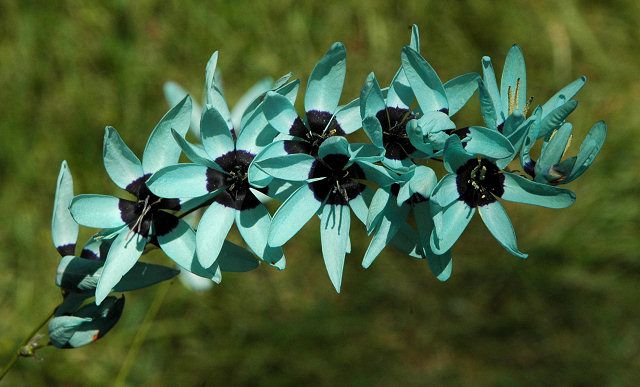

It is relatively difficult to find planting material for this type of ixia. The flat and small flowers are green in color, while the center is black and purple.
Ixia spotted (Ixia maculata)
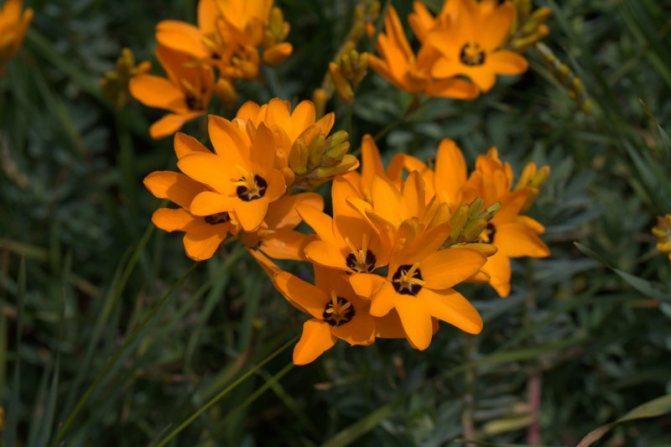

The bulb is rounded in diameter up to 30 mm. The height of the leafy stem is about 0.4 m. The basal leaf plates are narrow and lanceolate.The spike-shaped inflorescences include flowers that reach 40 mm in diameter and have a varied color with a dark center. The flowers are wide open during the daytime and close at night.
Chinese Ixia (Ixia chinensis)
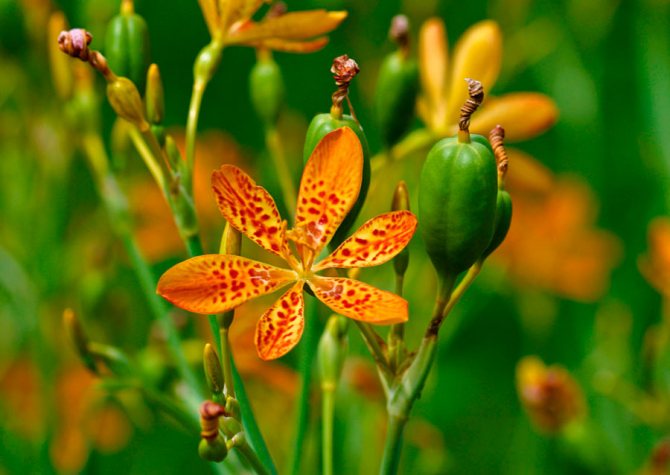

This species, which is a Far Eastern one, is endangered. The rhizome of the bush is short, and the height of the stems can vary from 0.5 to 1.5 meters. In the lower part of the stems there are 5-8 pieces of xiphoid leaf plates, reaching half a meter in length and 40 millimeters in width. Branching, spreading panicle inflorescences consist of 12–20 wide-open flowers of yellow or brown-red color, on their surface there are dark purple specks, and in diameter they can reach about 70 millimeters. The flower opens in the first half of a sunny day, while the beginning of its wilting falls on 17 o'clock. Quite popular among gardeners is the decorative form of the type of flava with large flowers of a solid yellow color, a fan variety (there is an overlap of leaf plates on each other by 3/4 of the length) and a variety of purpurea (flowers are colored red-yellow).
Ixia hybrid (Ixia x hybrida)
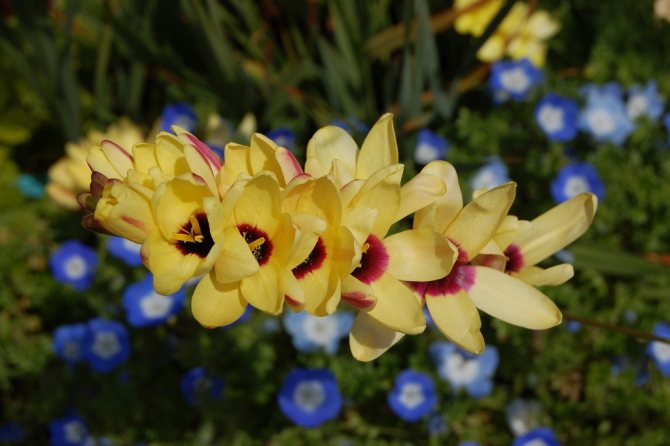

The height of such a perennial plant is from 0.3 to 0.5 m. Narrow leaf plates are arranged in two rows. Peduncles are leafless. Spike-shaped or racemose inflorescences consist of 6-12 funnel-shaped flowers, they can be painted in different colors, but their middle is dark red or brown. Flowering occurs at the beginning of the spring period, and it lasts about 20 days. Cultivated since 1770 Popular varieties:
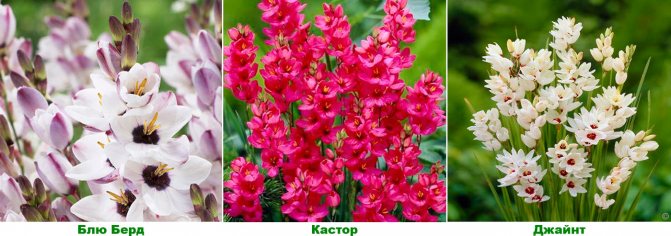

- Blue Bird... The flowers are colored white and blue.
- Castor... The color of the flowers is red.
- Giant... Inflorescences are creamy white.
- Earley Seprise... The flowers are red-carmine with white.
- Hogarth... Inflorescences are cream colored.
- Hollands Glory and Market... These varieties have yellow flowers.
- Mabel... The color of the inflorescences is red-carmine.
- Volcano... Inflorescences have a brick-red color.
- Rose Imperial... The flowers are painted in a delicate pink color.
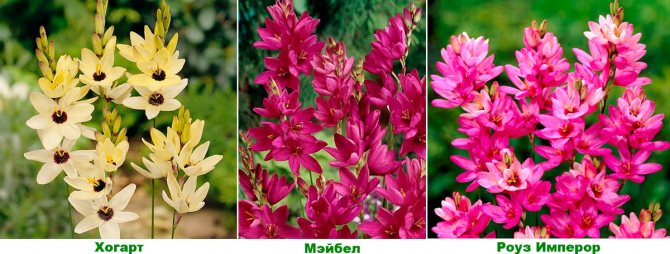

You can also buy the Ixia Mix variety, which includes plants of various colors.
Ixia. Photo
Winter period
As soon as the flower fades, it makes no sense to immediately remove the corms from the ground, since they still need to collect the required number of special substances. Basically, the bulbs are harvested on the end days of July. Corms must be dried in a shaded place with optimal ventilation. After they are treated with a strong substance of potassium permanganate and dried again.
To preserve the corms, it is necessary to place them in a box, which is hidden in a cold and dry place. Similarly, it is possible to save bulbs in the refrigerator. Earlier it was already discussed on the topic that it is necessary to plant Ixia in areas with a cold climate in the spring, and in warmer ones - in the fall.
If necessary, Ixia can be planted for distillation, in this version in the winter months it will be an amazing decoration of any room. In areas with very warm winters, Ixia is kept in the open ground for the cold season; for this, the yellowed and wilted aerial part must be removed, and the site is covered with a cover of mulch (straw, loose leaves, dry soil, sawdust or spruce branches).
Ixia. Outdoor cultivation
Step 1. When to plant Ixia
- Ixia is a thermophilic plant. In countries with severe winters, bulbs must be dug up in the fall in order to prevent their death. The tubers are thoroughly washed in a manganese solution and stored in a dry room at a temperature of about 10 degrees Celsius. In such countries, Ixia is planted in the spring, around May.
- If Ixia is grown in southern countries with mild climatic conditions in winter, then this plant can be planted both in spring and before winter.The Ixia planting site should be covered with a good mulch layer before winter, and removed in spring.
As you can see, the planting time of Ixia directly depends on the climatic zone and the specific temperature at a given time period. After all, the beginning of May this year does not have to be as warm as last year. Focus on long-term weather forecasts for your area.
Step 2. Choosing a place for planting Ixia
The main criterion for choosing the right place for planting Ixia is good illumination. With a lack of sunlight, Ixia flowers can wither away, lose the brightness of colors. Provide for "neighbors" for Ixia. It is advisable to avoid tall trees that will constantly create shade. Ixia prefers to grow in a calm and sunny place alone or next to other low-growing plants.
Step 3. What kind of soil does Ixia like
The tropical plant Ixia prefers to grow on light and airy soils with good drainage. Stagnation of water is extremely undesirable, as for all bulbous ornamental plants. Before planting Ixia in your area, prepare the soil well:
- the soil should be loose and well dug up;
- apply manure or humus (1 bucket per 1 square meter);
- also add 60-70 grams of superphosphate, 300 grams of wood ash and 25 grams of magnesium to the soil;
- the soil should not be "heavy". You can add some river sand to make the soil looser and lighter.
Step 3. Ixia. Landing
If you have already chosen a planting site and prepared the soil, then there is very little left to do:
- dig holes about 5-8 cm deep;
- at the bottom of each hole, you can pour a little ready-made nutrient mixture of soil;
- the minimum distance between the babies of the bulbs is about 8 cm, and between the corms - about 20 cm;
- bulbs must be carefully inspected before planting. Any damage, "wounds" should be sprinkled with wood ash, the bulb should be treated with a fungicide;
- cover the bulbs with earth and mulch the planting site;
- a very important rule for planting ixia is that this plant does not need to be watered immediately after planting;
- Ixia shoots should appear in 2-3 weeks;
- the first watering with warm water should take place just with the appearance of the first shoots.
Remember also that if the planting material was divided tubers, then Ixia will not bloom right away in the first year. This will happen in the 2nd or 3rd year of planting.
Characteristic
Ixia is an ornamental garden plant of the iris family. The charming decoration of the backyard territory is able to take root only in the warm regions of Russia. This is due to its origin from South Africa.
The height of an adult plant reaches 50 cm. The flower is a leafless peduncle with spike-shaped inflorescences in the form of bells. There are usually 6-12 flowers in one inflorescence. Ixia has a wide variety of colors. Its leaves are narrow and arranged in two rows. The fruit of Ixia is a tricuspid membranous capsule.
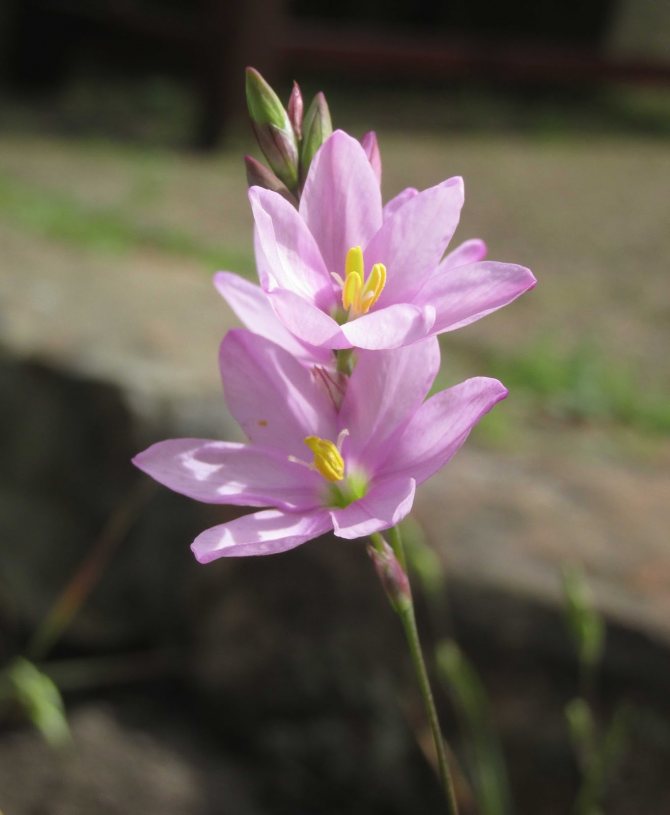

Ixia begins to bloom in May-June. This process is very short - 3 weeks. At this time, the plant emits an amazing aroma. At night, the flowers close, and with the onset of dawn, they again begin to delight others with their beauty.
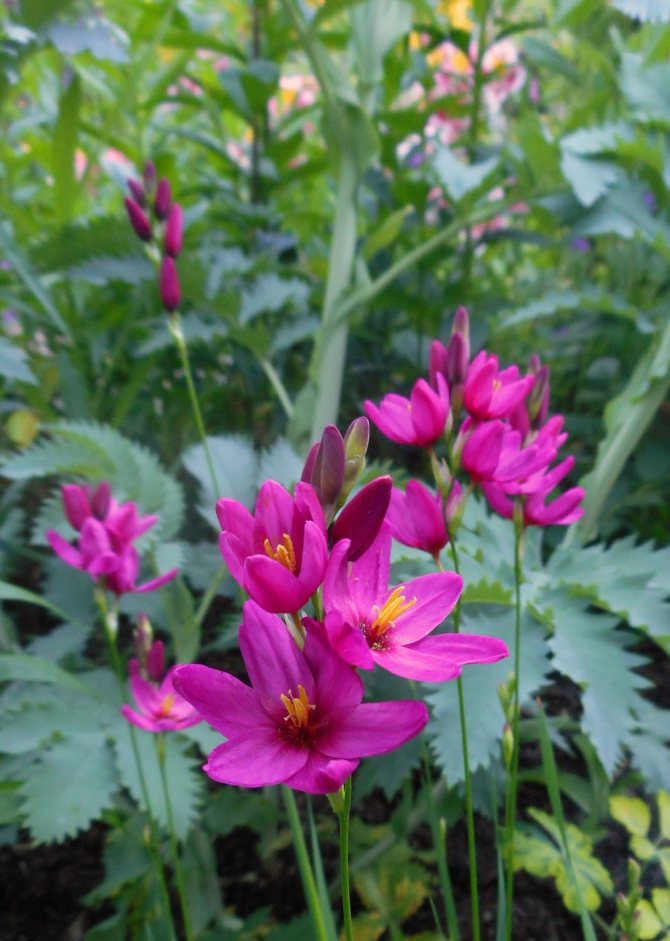

Like any representative of exotic plants, Ixia loves moisture and light. The plant needs to be given a lot of attention so that it does not die. The place for its landing is chosen with great care. Flowers grow best in a sunny meadow.
Ixia. Care
The African beauty Ixia is quite capricious in planting and leaving. This is not the plant that you planted and forgot about it. To enjoy the lush and bright flowering of Ixia to the maximum, follow these rules for caring for it:
- the first watering of Ixia should take place when the first shoots appear. Water for irrigation is used at room temperature or even slightly warm;
- during bud setting and during flowering, watering is especially important for ixia. The ground must be constantly moist. Do not allow it to dry out. Even a short-term lack of moisture can have a detrimental effect on the quality of flowering;
- ensuring good watering for the plant, do not forget that bulbous plants do not tolerate stagnant water. The bulbs may start to rot. To prevent this, a good drainage layer is needed;
- after the flowers of ixia have dried up, watering stops;
- remove dried flowers in time. They will only spoil the appearance of the plant;
- mulch the ground around the plant after each watering. This way you will preserve the maximum moisture for the plant;
- ixia, like any ornamental plant in a flower bed, responds positively to feeding. The introduction of various mineral and organic fertilizers will only increase the splendor of flowering and extend this period as much as possible. Specialty shops for gardeners have a huge range of ready-made bulb fertilizers. Read the instructions carefully and do not exceed the dose;
- after the ixia has dried up, you need to dig up its bulbs and provide them with comfortable storage conditions until next spring. In the southern regions with mild climatic conditions, this need disappears. Bulbs winter well in the ground. First, they need to be insulated on top with a good layer of mulch.
You can try to grow exotic Ixia in the apartment. But then leaving will be much more time consuming. First, you need to purchase a special lamp that will provide lighting for 16-17 hours. Secondly, you need to create special temperature conditions. The room should be about 10 degrees Celsius. As you can see, it will be quite problematic to organize such conditions in a living room. An ideal place can be a winter garden, a greenhouse, a loggia.
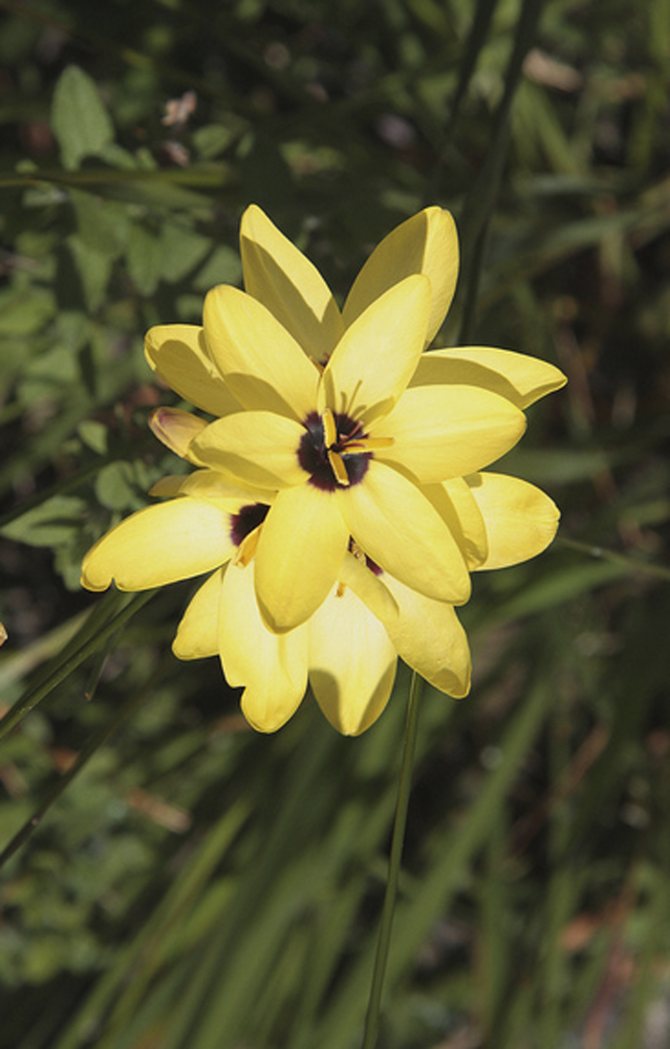

Growing and care
Ixia is weakly susceptible to attacks by various pests, but caring gardeners take care of it with anxious care. For reinsurance, the plant is planted in a new place every year. The main thing is the presence of fertile soil and an abundance of sunlight in it.
Outdoor care for Ixia is impossible without observing the rules of watering. After the first shoots appear, it can be watered, systematically increasing the abundance of watering. In dry weather, the plant is irrigated with a spray bottle, as it only likes moist air.
During the budding period, watering is done with great care. Special agents are added to the water that increase the frequency of flowers on the bush.
The plant is fed with mineral and organic fertilizers. Outdoor care for ixia is facilitated by the huge selection of specialized products in stores.
Timely removal of wilted parts not only improves the overall appearance of the garden area, but also makes it possible for new flowers to form. Faded ixia is practically not watered, in some cases this process stops altogether.
Due to insufficiently moistened soil, the leaves of the plant begin to wither. Do not forget about timely care in the open field and stop monitoring the moisture content of the earth every day. Excess moisture is also undesirable. Mold will then form on the bulbs.
Ixia. Bulbs and storage until spring
Every summer resident who has successfully managed the cultivation of the African beauty Ixia wants to repeat this next season. This is quite simple to do. Moreover, now you have valuable experience in planting and caring for Ixia. Consider the following guidelines for storing ixia bulbs in winter:
- you need to dig out the bulbs after the entire aerial part of the plant has already completed its cycle of development and growth;
- the bulbs must be carefully peeled from the ground and dried;
- then the bulbs are soaked in a solution of potassium permanganate for disinfection;
- after that, the bulbs must be dried again;
- we wrap the tubers in paper, newspaper sheets and store in the refrigerator on the lowest shelf until next spring.
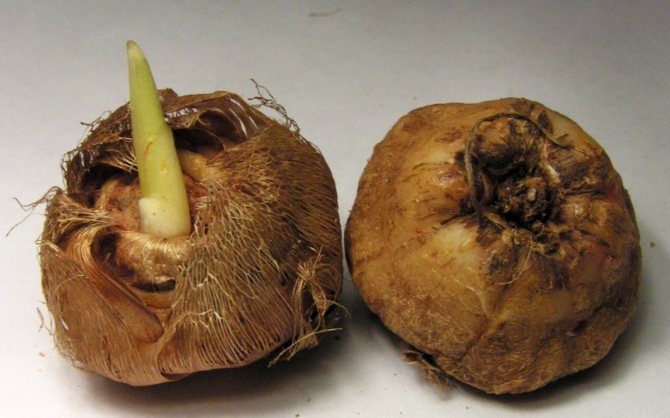

Some gardeners mistakenly believe that if the dug out bulbs are planted in a pot in the ground, they will survive better. But this is not the case. Of course, Ixia will feel great in the ground, but it will grow and by the time of spring it will lose its vitality. Growth and flowering will not be as intense as they could be.
Landing of Ixia
To acquire a vigorous, blooming plant, you need to understand how to successfully choose a place for it, prepare the ground and plant Ixia.
Choosing a landing site
Since the plant is southern and adores light and warmth, a windless, well-illuminated area of the garden, as far as possible from tall trees, will be a good site for it. It is very important to choose an area without stagnant waters, that is, Ixia should not be planted in the lowlands.
Soil preparation
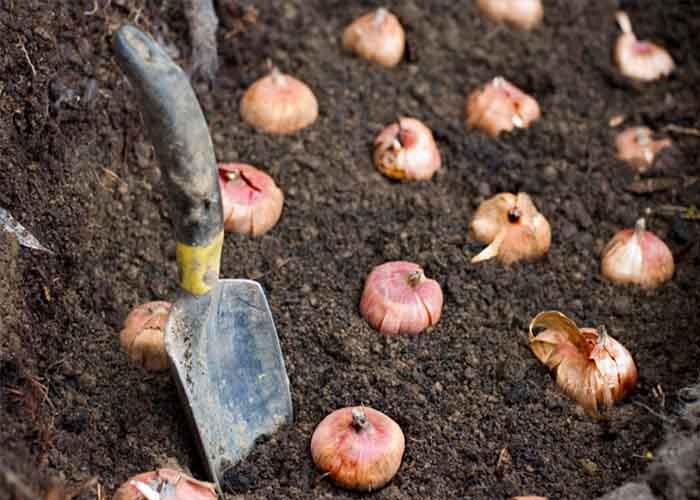

The flower adores earth with neutral acidity and humus. It very rarely happens that a mixture of garden soil is perfect for one or another plant, but it is possible to organize it with your own hands. To form the desired microclimate, the garden soil must be mixed with compost and sand. In the pit prepared for planting, there is drainage at the bottom so that water does not stagnate near the bulbs. After that, the collected nutrient mixture is substituted into the pit and spilled soundly.
Planting and transplanting
Planting and transplanting Ixia, in general, do not differ from each other. For both actions, a similar, above-named soil and site preparation follows. Pits for planting are made at a distance of 12–20 cm if shoots or part of the root are planted, and 20–25 cm when planting or picking whole corms.
Ixia must be planted to a depth of the size of the root, on top of it it is forced to be covered with soil by 1–1.5 centimeters.
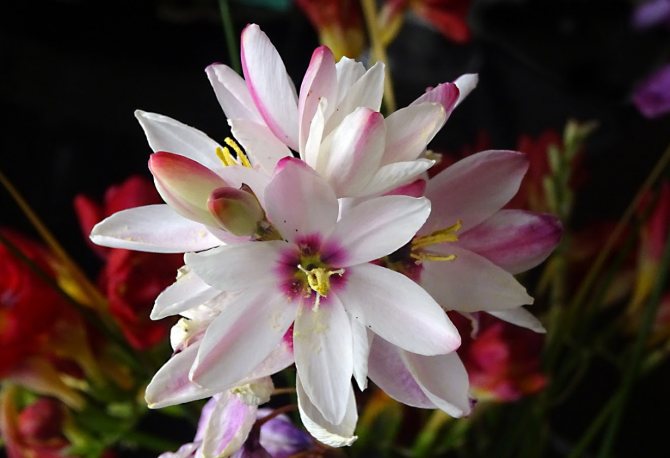

In the year of planting, only large bulbs have the ability to bloom. If parts of the bulb or shoots are sown, then flowering must be expected for the 2nd, and sometimes even the 3rd year.
Ixia. Reproduction
Propagation of ixia by seeds
The seed breeding method of Ixia is considered one of the most unpopular. Plants planted in this way will bloom only in the third year after planting. The seed method of breeding ixia is most often used by breeders when breeding new hybrid varieties. For convenience, small ixia seeds are mixed with sand and sown in containers. The first shoots should appear in 2-3 weeks. After the bulbs are tied, you can transplant the plants into open ground.
Propagation of ixia by root shoots
If Ixia has been growing on your site for the 3rd or 4th year, then its bulb can already grow with children. You will notice them immediately as soon as you dig out the root. The new shoots should be removed and placed in pots with a mixture of sand and peat. Plants propagated in this way can begin to bloom as early as the 2nd year.
Reproduction of ixia by dividing the bulb
Reproduction of ixia by dividing the bulb is one of the most popular methods. Plants can start blooming as early as the first year after planting. The procedure for dividing the bulb is carried out in the spring, just before planting. The bulb must be cut in such a way that each of the parts has an "eye" and a part of the rhizome. The place of the cut must be sprinkled with ash or brilliant green. to prevent decay processes.
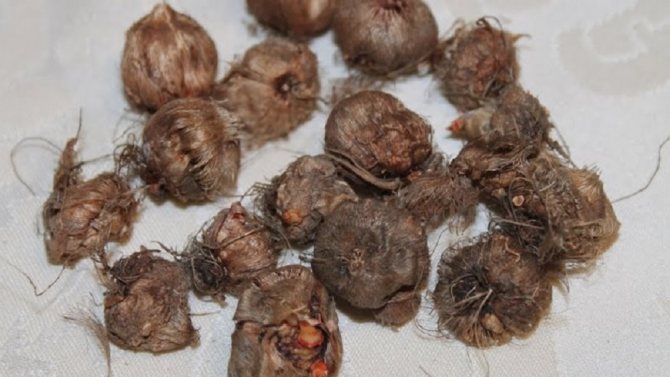

Site preparation
The site is selected with good drainage in order to exclude stagnation of moisture. Before planting Ixia, carefully prepare the place. For this, the soil is well dug up and fertilized with humus or rotted manure. The addition of wood ash, surephosphate and magnesium is allowed.
If the soil is not loose enough, then sand is added to it. Ixia cannot grow in heavy soil.To eliminate this disadvantage, river sand is also used in the amount of 1 bucket per square meter.
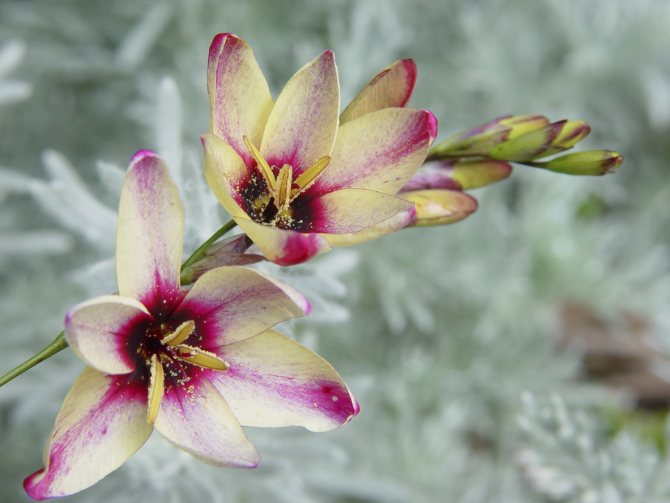

Ixia. Dangerous diseases and pests
To the great joy of novice gardeners, Ixia is well resistant to diseases and pests. This is a definite plus for a capricious African beauty. The only thing that you may have to face when growing ixia is rotting the bulb. How to suspect this ailment? It is possible to determine the beginning of rotting of the bulb by the following symptoms:
- yellowing of the peduncle;
- falling buds;
- a sharp deterioration in the appearance of the flower;
- loss of plant elasticity.
If you notice these symptoms, you can try to cut back on watering. If Ixia recovers quickly, then you are on time. If the appearance of the plant does not improve in any way, then you need to dig out the bulb. Perhaps the decay processes have intensified so much that it will have to be thrown away.
Main species and hybrids
The family contains about 44 types, of course, not all are used in floriculture.
- Ixia spotted (lat. I. maculata) is a well-known type, widely used by European growers for the design of rocky hills. It stands out with a tubular shoot 25 - 45 cm high. Contains well-opened flowers 3 - 4 cm in size, mostly yellowish with a dark scarlet middle. Blossoming occurs at the beginning or half of summer. This type has many subspecies.
- Ixia one-brother (lat. I. monadelpha) - a type with multiple subspecies, flowers in the shape of a star and all kinds of color, 4-6 pcs. in the inflorescence. The height of the flower is 18 - 25 cm.
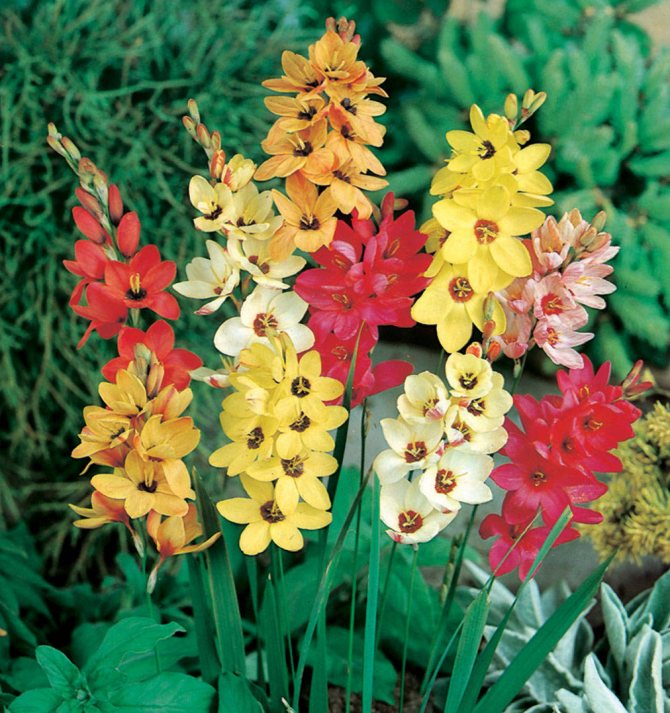

- Ixia fragrant (lat. I. odorata) - a type with bright lemon, softly fragrant flowers. Owns a spike-shaped multi-flowered inflorescence. Natural flowering occurs in early summer.
- Ixia eastern (lat. I. orientalis) - graceful type with matte pinkish or creamy snow-white colors.
- Ixia green-flowered (lat. I. viridiflora) - an extraordinary and extraordinary type with lilac-emerald or bluish-emerald flowers. The height of the stem is 25 - 30 cm. The inflorescence has a spike-like appearance. Unfortunately, planting raw materials of this type are very difficult to obtain.
Other popular types of ixia include: I. paniculata (Latin I. paniculata) and I. mnogokoloskovaya (Latin I. polystachya).
In floriculture, mixed ixia (Latin I. hybrida) are usually used, of which there are quite a few. Particularly fascinating in terms of the attractiveness of flowering are: Ixia Hogarth with slightly yellowish flowers, Mabel with pinkish-scarlet, Venus and Buttercup with pink flowers.
Ixia. Use in landscape design
Ixia is an exotic and charming flower that will look great almost anywhere on the site. Someone thinks the cultivation of ixia is a troublesome business, but for someone any worries about a flower only bring joy. It all depends on your desire and capabilities. Ixia will look great in the following places on the site:
- rocky rockery;
- flower bed;
- alpine slide;
- containers;
- flowerpots.
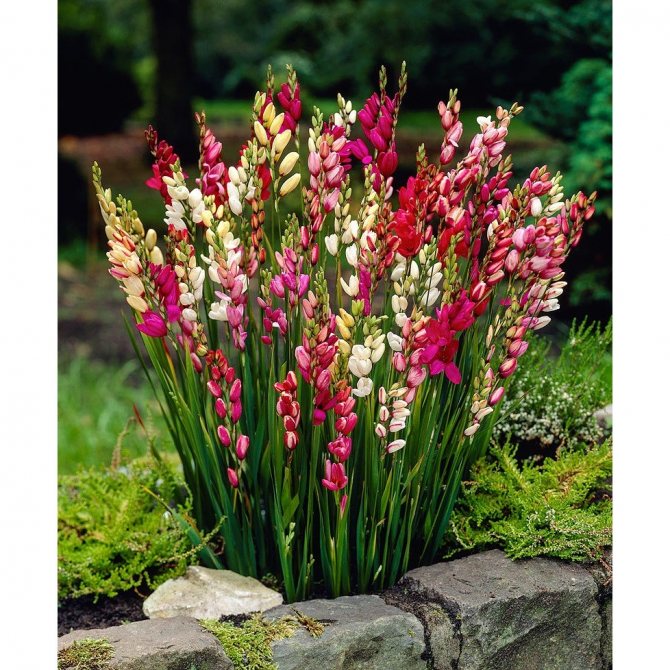

The huge color variety of ixia flowers allows it to be successfully combined with a variety of ornamental plants. Gardeners combine this African beauty with plants such as:
- gladioli;
- freesia;
- petunia;
- lobelia;
- Fassena;
- catnip;
- linen;
- miscanthus;
- reed grass.
When creating flower beds, consider the basic rules for combining colors. Plants that are completely contrasting in color and similar in shades look spectacular. "Mix" varieties of Ixia are popular, which will create a real fireworks of colors for you. Exotic Ixia will look great and just on the lawn. The simple shapes of its flowers will create the natural charm of nature. Experienced gardeners very often use a tricky technique when planting neighbors for ixia. These should be plants that are the same growth as her.The thin stems of Ixia will "lean" on these plants and be supported.
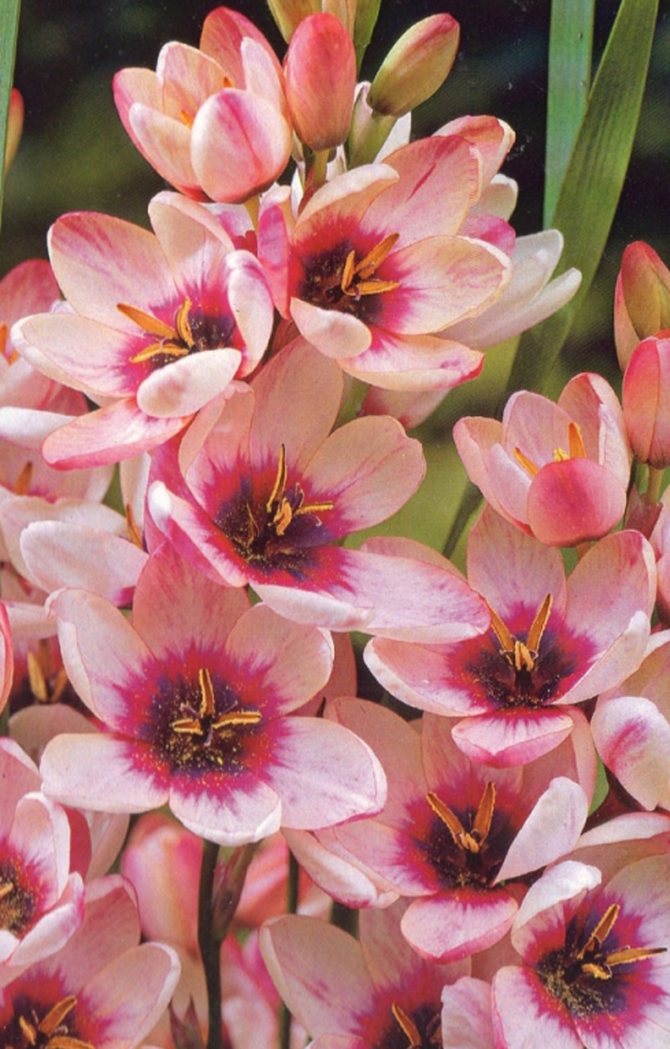

Ixia is very often grown for the decoration of the beds in the garden. Fragrant flowers are perfect for cutting bouquets. You need to cut flowers for a bouquet when the buds are not fully blossomed. Such an amazing bouquet will stay in water for about 3 weeks.
Don't be afraid to try your hand at raising this African stranger. In Ixia, planting and care in the open field is difficult only in theory. Once inspired by its lush bloom, you will not be able to forget it. Good luck!
Varieties
Gardeners usually prefer Ixia hybrida. Its flowers are like small stars. It is best suited for backyard decoration and forcing.
Popular varieties of Ixia hybrid:
| Name | Coloration |
| Hogart | Creamy yellow |
| Blue bird | Blue |
| Mabel | Carmine pink |
| Nelson | White |
| Vulcan | Bright orange |
| Goliaph | Red (large size) |
| Castor | Red |
| Early surprise | Carmine red with white |
| Giant | White-cream |
| Holland's Glory | Yellow |
| Rose emperor | Light pink |
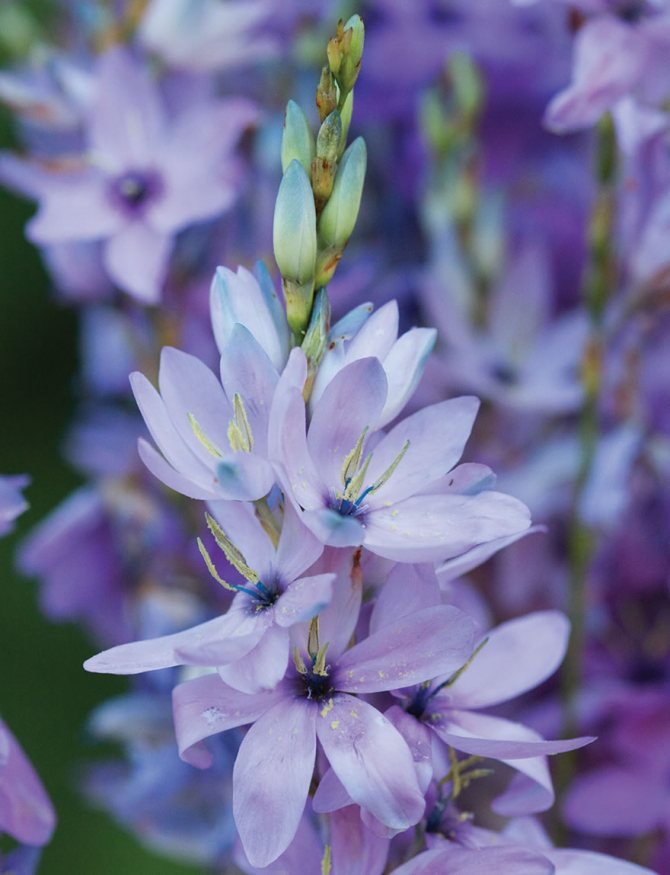

The following types are still widespread:
- early hymenocallis;
- green-flowered;
- spotted;
- orange.
Early Ixia hymenokallis is capable of reaching a height of 70 cm. The petals of a green-flowered plant are colored green, which stands in contrast to the bluish-black pharynx. Spotted Ixia has white petals with light purple edges. The orange look is distinguished by its low height - only 20 cm.
How to properly plant Ixia bulbs
Before you start planting Ixia, you should carefully examine the bulbs and take only intact, elastic specimens with a diameter of about 5 cm and an age of 3-4 years.
When choosing the time for planting, you should focus on the climatic features of the region. This work can be carried out both in autumn and spring. In central Russia, it is more advisable to plant in the warm season after the threat of frost return has completely passed and the soil warms up well. Usually this work is done in early - late May. Residents of temperate latitudes plant Ixia in mid-April.
Planting ixia bulbs on a personal plot is also possible at the end of autumn, but for this you need to create conditions for them so that they do not freeze out in a cold, snowy winter. In this case, the bulbs should be buried in the soil by 10-15 cm, cover the plantings with a thick layer of mulch, which is suitable for sawdust, peat or straw. In spring, clear the area with crops from mulch using a rake.
Before planting the bulbs, it will be correct to stand for 30 minutes in a weak solution of manganese. This procedure provides the seed with protection against various fungal diseases. After the specified time, the bulbs are washed under running water. After that, the bulbs are harvested for germination in a fairly wide container with low edges, filled with a mixture of coarse sand and sawdust. The soil layer should be about 10 cm. The seed is placed close to each other. The box is covered with foil or glass, then placed in a warm, well-lit place. The shelter is removed daily for 10 - 20 minutes for ventilation. Bulbs will sprout in these conditions after 2 weeks. If this does not happen, then the bulb is not suitable for planting. Sprouted bulbs are placed in the soil in a permanent place in the second decade of May to a depth of 7 cm.The distance between them should be at least 20 cm. The soil is covered with a small layer of humus on top.
Planting in the fall has its own characteristics. It should be borne in mind that this culture does not have high frost resistance and is capable of being damaged at temperatures below -15 degrees. This suggests that autumn planting is permissible only in regions with a mild climate. In this case, the bulbs are planted in early September - late October.
When preparing a site for a plant, the soil is fertilized, furrows are made and the bulbs are buried.Top covered with a layer of earth. The distance between the bulbs is about 20 cm. The planting depth is 12 cm. After planting, the ridges are mulched with dry fallen leaves to prevent freezing of the bulbs in winter.
How to plant
The easiest way to plant the plant is with corms, which are similar in appearance to tulip bulbs. In the middle lane and the Moscow region, Ixia is planted only in the spring, since it does not tolerate frost at all. In southern regions, with warm winters, it can be planted before winter.
Healthy ixia bulbs are planted in a prepared bed when the soil warms up. Around April - May. The tubers are immersed in the ground to a depth of 5 - 7 cm, the distance between the plants depends on the height of the variety, and is 15 - 25 cm. The plantings are mulched with a small layer of humus (2 - 3 cm), do not watered. Seedlings will have to wait up to 3 weeks.
When planting bulbs in the south, a bed with ixia is mulched with a layer of sand, 3-4 cm thick.
Care
In order to grow a real decoration of a garden, balcony or room, Ixia must be properly looked after. Comprehensive care includes:
- watering;
- mulching;
- loosening;
- pruning;
- treatment;
- preservation of bulbs in winter conditions.
Growing Ixia will not take a long time from the gardener.
The first watering of Ixia is performed only after the sprouts hatch. This will happen approximately 2-3 weeks after planting. Further, you need to water the plant intensively, especially during the period of budding and flowering. It is advisable to add complex fertilizers to the water for irrigation, which will make the flowers more saturated in color, and also increase the flowering time.
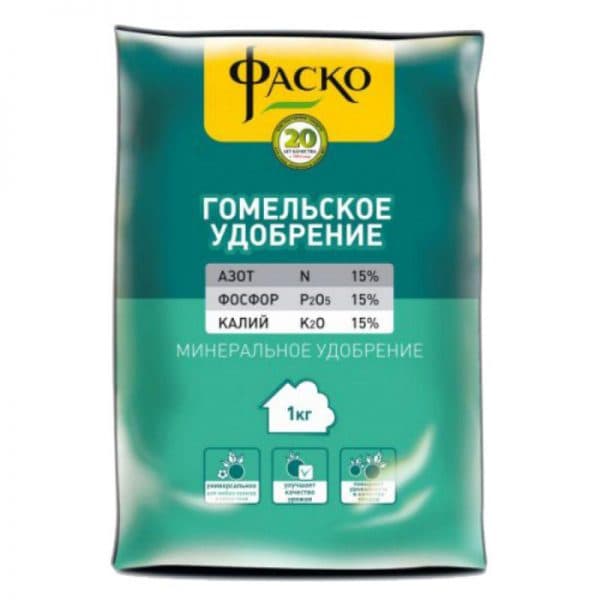

Fertilizer
Mulching and loosening should be done immediately after planting and repeated periodically throughout the summer. These procedures will help to retain moisture at the roots and prevent crust formation on the soil, thereby providing oxygen to the bulb. Mulching is carried out with peat, sawdust or dry foliage.
Watering
Plant care implies proper watering. As already mentioned, after planting, the plant is not watered for several weeks. This is done as soon as the first shoots appear, gradually increasing the intensity of watering. During the budding period and during flowering, the flower must be watered as much as possible using special complex preparations that make the flowering more abundant. When growing ixia, you should know that it prefers humid air, therefore it is recommended to spray it from a sprayer in hot and dry weather.
Bulb care and reproduction
In autumn, after digging, the bulbs are washed with potassium permanganate and dried. For storage, they are placed in a room with a temperature of at least 10 degrees.
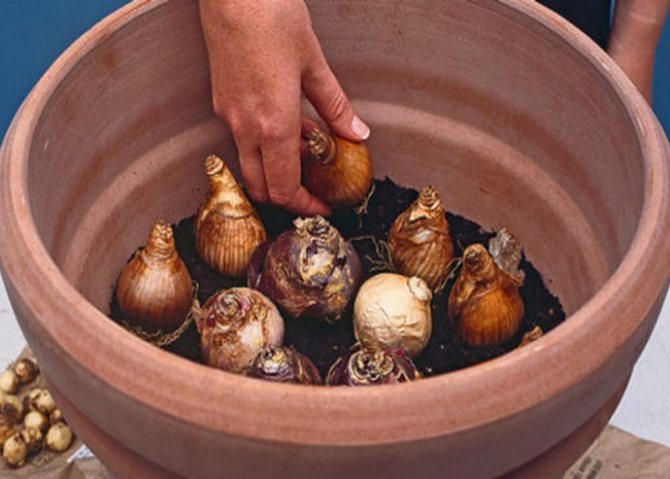

Plants are propagated by "children", which are separated from the main tubers when digging up, and by seeds. The "babies" planted separately from adult bulbs give flowers in the second year, while the flowering of plants grown from seeds is achieved only in the third year.
General information about the plant
Ixia is a genus of the Iridaceae family. These are perennial herbaceous corms. With thin stems and xiphoid or lanceolate leaves. Inflorescences are spicate or racemose. Flowers can be funnel-shaped, and they are also actinomorphic. Their color is very diverse: pink, red, yellow with a black center.
Their aroma is light, but specific. It attracts bees. Blooms from late spring to early summer. Flowers are mostly closed on cloudy days. There are about 25 species in the genus. But in culture, only hybrid forms are used. The origin of many of them is not exactly known.
Preparing for winter
Since the nodules of the tropicana are not able to overwinter in our climate, gardeners have found the optimal algorithm for growing these flowers.The end of the growing season, when the inflorescences have bloomed on the plant, the seed pods have formed, the seeds have ripened and the foliage has begun to dry out, is a signal for the grower that it is time to dig out the corms. For digging, choose a day in dry, sunny weather.
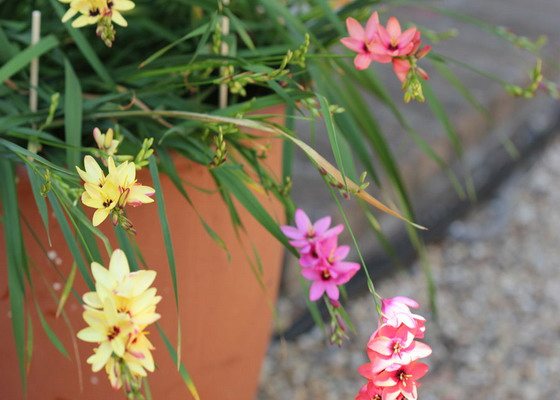

After the planting material is removed from the soil, the nodules are laid out and dried in the sun for 5-7 days. Then they are dusted with ash and put in cardboard boxes for storage in the winter. The boxes are stored at a low above-zero temperature (10-15 degrees Celsius), periodically ventilated and checked for general condition. Important! If a spoiling onion is found during the winter inspection of stored flower tubers, it is immediately removed so as not to infect the rest of the planting material.
When to dig
After flowering at the end of July, carefully remove the bulb from the soil.
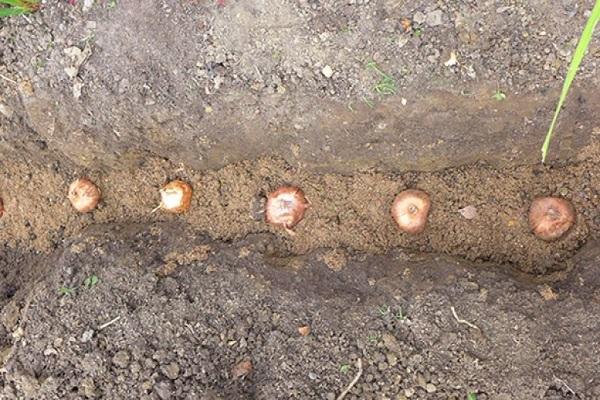

How to dig and store
Dry the excavated material in a well-ventilated place, soak it in an antibacterial solution of potassium permanganate and send it back to drying. Next, put the bulbs prepared for wintering in a dry box, which should be placed in a dry, cool place.
If you want to enjoy flowering and in winter, plant the bulbs in indoor pots and put them on the windowsill.
Subsequent landing in the ground
The next landing depends on climate conditions and is no different from the aforementioned landing dates.
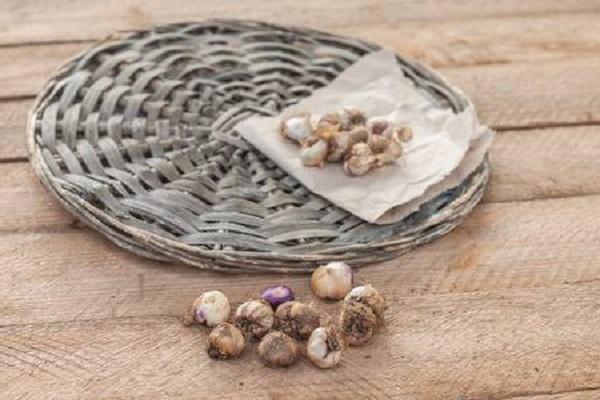

Choosing a landing site
Since Ixia belongs to the representatives of southern plants, accordingly, for its planting, it is necessary to select an illuminated area with sufficient moisture. Despite the high humidity, the soil must have good drainage, excluding stagnant water. Before planting a plant, the selected area is dug up and fertilized with humus, if a looser soil is created, sand is added. Heavy soil is by no means suitable as it has an adverse effect on growth and flowering. It is also advisable to fertilize it:
- 300g wood ash;
- 70 g superphosphate;
- 20 g magnesium.
To prevent the development of diseases, it is advisable to change the location of the flower on the site annually.
Combination with other colors
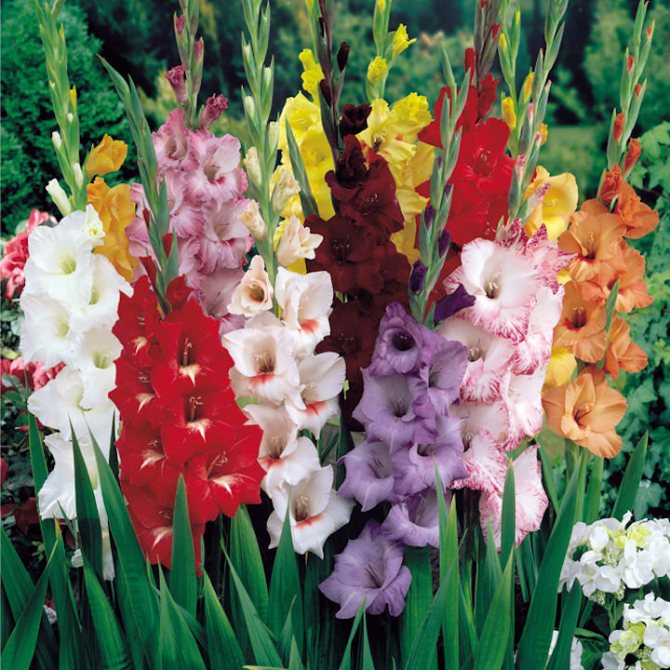

Some of the best neighbors for Ixia are freesia and gladioli, which are equal in height. But it is better to plant them not interspersed with these flowers, but in separate meadows.
Ixiae are also good next to multi-colored annuals - white petunia, red salvia, multi-colored lobelia. Pink carnations and seaside armeria are an excellent combination with African exotics.
The blue and white neighbors - catnip, flax, Fassena - placed at the foot of Ixia will give them a special exquisite beauty.
Planting bulbs
A few days before the planned planting, all bulbs are checked after wintering: only dense, strong bulbs without signs of mechanical damage or mold are allowed for planting work.
In the soil prepared in advance that meets the requirements of the plant, the holes are cut every 10 cm (8 cm is enough for children and divisions).
A handful of compost or humus is thrown into the holes, the soil is trimmed with ash and the corms are placed on the heels, sealed to a depth of no more than 8 cm.
After filling the holes and slightly compacting the soil, the plantings are mulched no more than 3 cm and do not watered until shoots appear.
What time to plant
If Ixia is grown in areas with sufficiently warm and mild climatic conditions, then its planting in open soil can be carried out in spring (from the last days of April to the first days of May) or in autumn (in November). Since the planting material of this plant dies at a temperature of less than minus 1-2 degrees, then in middle latitudes, as well as in colder regions, it is planted only in spring.
Each season for planting ixia, it is recommended to choose a new site, which serves as a good prevention against diseases and pests.A site should be chosen well-lit, located away from trees, and also protected from gusts of wind. Ixia grows best in fertile, neutral soil saturated with humus. For planting, those areas where there is stagnation of liquid are not suitable.
Loading ...
Major diseases and methods of treatment
Regarding parasites-pests, and similarly to diseases, it should be noted that Ixia is quite stable to them.
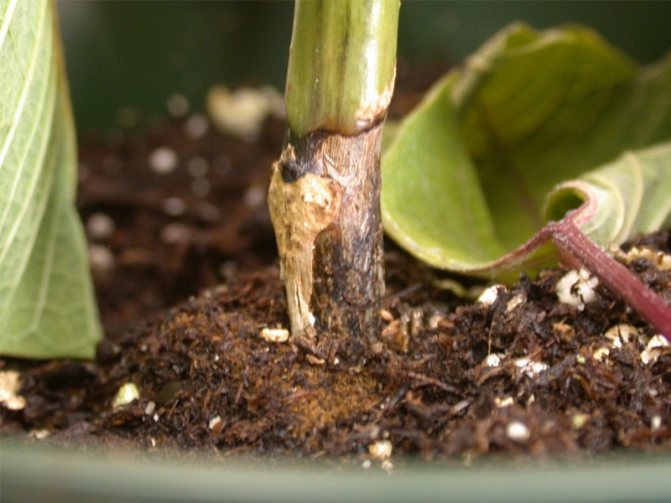

One problem that is faced the most is that the bulb is damaged by mold and rot, due to excess moisture. In this embodiment, there is a decline in the state of the planting, lemon color of the peduncle, weak buds, which are separated not yet open. When the first symptoms are observed, it is necessary to interrupt the moistening, to help ventilate part of the roots. If the flower looks more alive, therefore, you ripened in time. If on the contrary, then you need to get the bulb, and as a result of its rotting to eliminate.
Storing Ixia bulbs
When growing ixia in mid-latitudes, it is advisable to store them indoors during the winter. The bulbs are dug up after the plant has completely bloomed and the seeds are ripe. This work is not carried out in wet, cloudy weather. The dug out bulbs are spread evenly on a dry surface in a well-ventilated area and kept for a week. After that, they are transferred to wooden boxes and sprinkled with ash on top. Store in a cool place at a temperature of 12-16 degrees. The lower shelf of the refrigerator is also suitable for this purpose.
In regions with a warm climate, the bulbs are not dug up, but left in the ground for the winter. With the onset of autumn, the aboveground part is cut off, the area with the plant is covered with a layer of mulch, which is used as spruce spruce branches, straw, dry foliage or sawdust. In this case, the bulbs will overwinter successfully, and in the spring they will sprout new sprouts.
Ixia care in the garden
How to care for Ixia.
Planting Ixia and caring for it is not difficult, but the agricultural technology of this culture has its own characteristics. The most important conditions for the successful cultivation of Ixia are bright light, high temperature and high air humidity, therefore, it is justified to grow Ixia in the bright sun, and to create high humidity, evening spraying will have to be carried out. If Ixia is planted in partial shade, it will not fully show its decorative qualities: the peduncles will be too long and thin, and the color of the flowers will be dull.
Reproduction
Reproduction of Ixia is carried out in several ways: by children and by dividing the corms.
Children
Small outgrowths are formed around the maternal corms, which are called babies. Carefully separate them, and cover the attachment points with coal powder and send them to the holes. Flowering occurs in the second or third year.
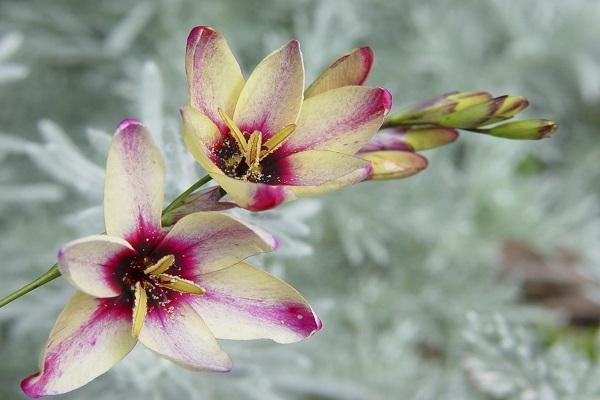

By dividing the bulb
It is considered the most optimal breeding option. To do this, cut one onion into parts, but only so that each of them has buds, well, or at least one, as well as root rudiments. Sprinkle the planting material using wood ash at the cut, and plant it in the soil. A properly divided bulb will form and bloom this year.
Exotic and unusual Ixia can be easily grown in your own garden, even though the culture is not adapted for growing in our region. Subject to all the conditions of planting and care, you can achieve the desired result, decorate the garden area and simply cheer up.
Plant characteristic
The homeland of this exotic flower is South Africa, but it can increasingly be seen in Russian gardens. Ixia is distinguished by thin erect stems and reaches a height of 50 cm.Very beautiful flowers in the form of a bell are collected in a spike-shaped inflorescence and can be red, white, yellow and pink... The plant begins to bloom profusely in late July or early August, but this does not last long - about four weeks, then the leaves begin to dry.
Flowers close at night or in cloudy weather. The sap of this plant is highly sticky, which was previously used for catching birds, and a rather strong aroma can attract bees and butterflies.
The abundant flowering of ixia depends on proper care, which is as follows:
- enough sunlight;
- frequent watering;
- regular removal of dried petals;
- fertilizer-rich soil;
- the optimum air temperature is 18–20 degrees;
- loosening and drainage of soil.
Description, photo and biological features of the plant
This attractive flower is a bulbous tuber from hot tropical countries. Like any green inhabitant of those latitudes, Ixia has an attractive appearance. Thin stems framed by narrow and long sword-leaves combined with exquisite flowers in the shape of symmetrical stars. There is a dark spot in the middle of each of them. It is the hallmark of a summer cottage beauty.
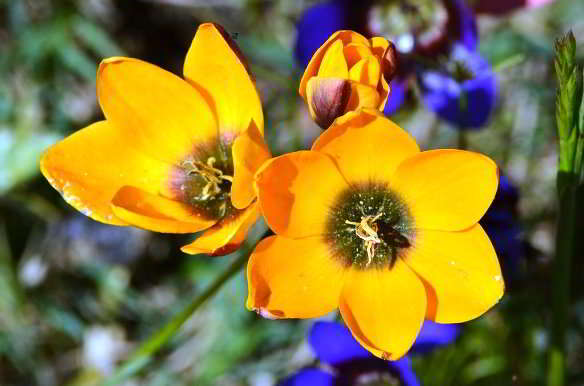

During flowering, it smells sweet, albeit slightly, but the aroma is quite specific. At night, the petals close and the tropicana rests in order to open up in the morning and please the owners. Color options are very diverse, on one stem there can be up to a dozen buds. There are even varieties with double flowers. In height - from 30 to 70 cm.
The southern beauty blooms in late spring and early summer. A short (only about three weeks) but bright riot of colors is a real gift for gardeners.
Forcing flowers
In order not to wait for summer, and to please yourself with the wonderful flowering of Ixia, when there is still snow outside the window, the flower is kicked out of the bulb in ordinary pots.
For this, the substrate from a mixture of humus, sand and peat is filled with a complete mineral fertilizer (Kemira, Agricola, Aelita flower). Pots need to be taken with a volume of 300 - 500 ml.
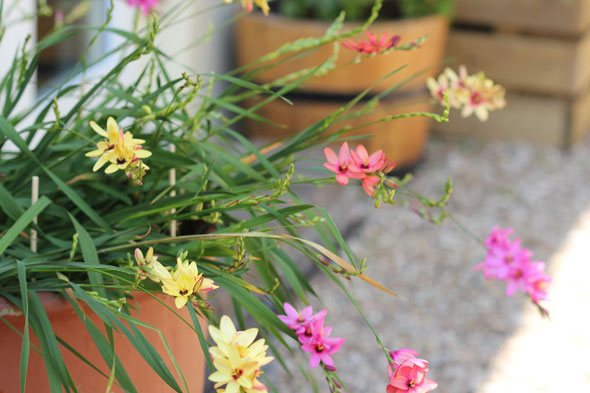

The bulb is planted to a depth of 5 cm, without watering, waiting for shoots. It is important to place young plants on the lightest window or to supplement the illumination with phytolamps, arranging daylight hours for at least 12 hours. It is important to spray them daily, as the air in our apartments is too dry for Ixia.
If you plant the bulbs in early January, in March you can already enjoy the wonderful delicate bloom of a tropical guest.
When Ixia blooms
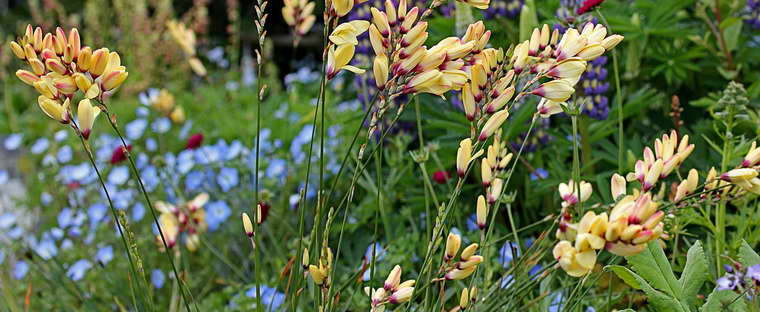

Ixia cultivar Ixia 'Buttercup' photo
Mass flowering of Ixia begins in mid-summer - the second decade of July and lasts until September. In place of wilting flowers, seed pods appear and ripen.
Ixia enchants with its aroma, attracting also insect pollinators, which makes it one of the wonderful melliferous plants.
The flowering of ixia is a real fireworks of colors: white, yellow, pink, orange, sand shades, the whole spectrum of red, there is a kind with a green tint of inflorescences, but the tones are warm. The core is decorated with a spot in a contrasting shade. In shape, the flowers are symmetrical asterisks, the inflorescence is in the form of an ear.
By the way, the beginning of cultural floriculture was laid by the ancient Egyptians more than 4,000 years ago.
As a real southerner, Ixia loves warmth and sunlight, it is in such conditions that the flowering is most luxurious. In cloudy weather and in the evening, the corollas are closed, but as soon as the sun's rays slip, they will open again.

